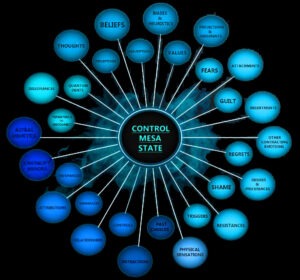Today, I want to share something you’ve never heard of before: MADR theory.
It will help you understand what all those sleepless nights caused by relationship conflicts were really for—what all that longing after breakups meant, and what specific lessons each relationship and each parting carried.
Wouldn’t you want to know?
Mesa Anchors Destabilizing Relational (MADR) Theory, a branch of the MetaMind Bend (MMB) Model, introduces a paradigm shift in how we understand relationships, trauma, and identity construction. I want to explore in this stream of consciousness, MADR Theory in dialogue with contemporary relational theories, attachment models, and trauma research.
Where traditional psychological frameworks often pathologize relational dysfunction or aim to restore attachment, MADR suggests that relationships function as destabilizers of inherited (false) identity architecture—catalysts that expose internal structural contradictions for the purpose of conscious evolution. I would like here to share and explore with you MADR’s central claim: that relational rupture is not a sign of failure but a functional diagnostic event meant to unanchor false coherence.
In conventional therapeutic paradigms—such as Attachment Theory, Emotionally Focused Therapy, and even Polyvagal Theory—the goal of relationship healing is typically framed as restoring secure attachment, regulating affect, and re-establishing interpersonal coherence.
MADR Theory diverges sharply from this by suggesting that the purpose of many high-impact relationships is not coherence but collapse—not the relationship but the false “self”—the collapse of misaligned identity structures formed through unresolved internal anchors, or what the MetaMind Bend framework refers to as Mesa Anchors.

Mesa Anchors are multi-domain imprints: habitual patterns, perceptual distortions, inherited roles, suppressions, aesthetic projections, somatic contractions – I identified 40 Mesa Anchors with which we work in the MMB (around which our MMB Identity Gap Assessment is designed). These are not simply “beliefs” or “wounds,” but complex energetic-cognitive entanglements that shape the way individuals perceive themselves and others. The MADR framework argues that significant relational events, particularly in romantic, familial, and high-stakes professional contexts, destabilize these anchors to reveal identity fractures that have long gone unnoticed.
Relationships as Diagnostic Pressure Systems
In the context of MADR Theory I would like to assert that relationships function less as containers for safety and more as mirror laboratories—activating long-dormant identity roles. This perspective is in alignment with Jungian notions of shadow projection (Jung, 1959) and object relations theory (Fairbairn, 1952; Winnicott, 1965), yet extends these by introducing a systemic and quantum mapping of identity response: the Mesa Anchor Loop.
Where Freud might describe neurosis as a repetition compulsion and relational theorists might name “trauma reenactment”, MADR maps these repetitions as intentional structural feedback loops—each designed to reveal where the psyche has outsourced integrity to outdated roles. The partner who “betrays,” “abandons,” or “rescues” us is not seen as the source of pain, but the reflective pressure that exposes internal incoherence.
MADR aligns with somatic trauma healing disciplines by recognizing that identity is not merely a cognitive construct, but a somatic and energetic system. Where MADR diverges, however, is in treating identity itself as inherently unstable—and suggesting that rupture is not to be healed, but decoded.
From Mesa to Meta: The Arc of Identity Evolution
The MetaMind Bend Model frames human development as a cyclical descent from a state of Meta (undivided consciousness) into Mesa (anchored identity), and, ideally, a return back to Meta through deliberate unanchoring. MADR proposes that this unanchoring is most potently activated through relational rupture.
Drawing parallels to Grof’s work in spiritual emergency and Bateson’s double bind theory, MADR treats the relationship as a quantum container—a place where multiple timelines, unmet internal contracts, and energetic contradictions collapse into a single transformational event. The “breakup,” in this lens, is not an ending, but a puncture—what MADR calls a Quantum Dent (One of 40 Mesa Anchors we use in the MMB): a multidimensional distortion in perception, behavior, and energetic coherence.
Such dents, MADR theory proposes, hold the key to psychological liberation—not through analysis alone, but through relational decoding: identifying the roles performed, contracts entered, and suppressions enacted within each relational dynamic.
The MADR Method: Deconstruction, Not Repair
Rather than resolving the emotional residue of relationships through closure, MADR insists on a deeper forensic unpacking of the internal architecture that necessitated the relationship.
Using tools like the Identity Gap Assessment, MetaMind Bend Model maps seven distinct domains of identity fragmentation:
- Cognitive: Internal narratives, distortions, logic splits.
- Emotional: Suppressed affect, compensatory empathy.
- Physiological: Somatic contraction, stress memory.
- Behavioral: Role repetition, trauma responses.
- Relational: Boundaries, fusion patterns, attachments.
- Causal: Origin timelines, ancestral patterning.
- Energetic: Frequency distortion, magnetic incongruence.
These domains correlate to observed consequences such as chronic illness (Maté, 2003), decision fatigue, diminished life-force, and confusion about purpose. The act of unanchoring post-relationship, then, is not about moving on—but about moving inward, deconstructing the scaffolding that collapsed under relational pressure.
A Reframe on Rupture: Not Incompatibility, but Instruction
Where many trauma and relationship models emphasize compatibility, healing, or secure attachment as the goal, MADR proposes that fracture is the point. Echoing Zen koans and paradoxical logic, MADR suggests that the identity rupture produced by a relationship is the first honest moment in the evolutionary arc of the self.
Just as Mezirow emphasized transformative learning through disorienting dilemmas, MADR treats breakups and relational implosions as intentional thresholds—designed to reveal the hidden contracts and archetypal scripts that shaped the self.
MADR diverges from conventional post-breakup narratives by arguing that the person you chose was not a mistake, but a mirror—deliberately selected to expose your own identity incoherence.
Why MADR Theory and the MMB Approach to it Matters (me thinks): Beyond Therapy, Toward Awakening
The implications of MADR theory stretch far beyond relationship counseling. It offers a meta-theoretical framework for:
- Resolving recursive relationship patterns through systemic deconstruction.
- Restoring energetic coherence through identification of internal contracts.
- Retrieving suppressed instinct, vision, and vitality otherwise locked behind inherited roles.
- Transcending false identity architectures not through ego repair, but through role detachment and Mesa Anchor neutralization.
Failure to engage in MADR-inspired MMB process of relational unanchoring may result in the perpetuation of karmic patterns under new guises, persistent health and mood disorders, and chronic identity disorientation.
In contrast, MADR-guided deconstruction yields:
- Emotional neutrality and energetic liberation,
- A clean perceptual lens to re-enter any relationship from clarity,
- A stable self-definition rooted in signal congruence, not projection,
- Increased discernment and resonance in future relational attraction, or
- Clear relationship repair through the meeting of two more evolved beings.
The Future of Relationship Psychology
MADR Theory proposes a radical yet rigorous reframe: Relationships are not designed to complete you. They are designed to expose where you’ve not been whole.
By treating relational rupture as a diagnostic event, not a failure, MADR repositions relationships as ontological interventions—engineered to dismantle the false scaffolding of identity and force coherence where there was fragmentation.
Where conventional models promise peace through connection, MADR promises liberation through collapse—and the reconstruction of identity not from attachment, but from awakening. And awakening automatically brings peace. It’s having two for the price of one.
As future research emerges around quantum trauma fields, identity contracts, and energetic coherence, MADR may stand as a new organizing framework for both high-functioning individuals and clinicians ready to abandon the soothing repair model in favor of a transformation model grounded in multi-domain deconstruction.
SOUL CONTRACTS: A POST-METAPHYSICAL RECONSIDERATION
Am I putting you to sleep with all this academic stuff?
Ok, let me add pep to my step then… 🙂
So, what if this whole “pre-birth contracts” deal?
The doctrine of “soul contracts” has long floated through esoteric traditions with the seduction of a metaphysical prenup—one allegedly signed in utero or in some nebulous pre-incarnational waiting room. According to this view, each trauma, betrayal, chronic illness, and improbable reunion was not only fated but drafted, itemized, and agreed upon by your soul, presumably during some kind of divine PowerPoint presentation with a council of interdimensional auditors. This framing—half myth, half metaphysical HR protocol—carries with it both comfort and an unsettling fatalism: You agreed to this.
It might all be true—or it might not be that at all. It could simply be a myth, or a metaphor. (Which, frankly, is a useful lens if you haven’t had a direct experience of knowing it for sure.) So let’s set aside esoteric assumptions for a moment, and approach this from a different angle.
So, what if that contract isn’t cosmic, or eternal, or pre-birth at all? What if it is—like most contracts in any field—a local, temporal construct? Not a blueprint from a spirit world but an emergent explanatory metaphor, drafted by the psyche to reckon with experience? What if the relevance of “soul contracts” has less to do with destiny and more to do with the human compulsion for narrative closure, self-responsibility, and meaning through tension?
Let’s begin by asking: why do we want it to be a contract in the first place?
The Spiritual-Scientific Split: A False Dichotomy?
Within New Age and Eastern-influenced spiritual disciplines, soul contracts serve as a metaphysical accounting tool. Vedanta frames karma as the binding force of consequence, and in many schools of Hindu and Buddhist thought, the soul’s trajectory is not so much contracted as it is encoded through samskaras and vasanas—subtle impressions and habits carried over from previous incarnations. Western esotericism, on the other hand, popularized the language of pre-birth planning. Think Michael Newton’s Life Between Lives, or the Akashic Records crowd who make the Akashic field sound like a divine DMV: eternal, bureaucratic, and a little smug. (Akashic Records reading folks, I am just pulling your legs! 🙂 ) The field is the field. Information is in all expressions of the divine mystery…
So, science, particularly in developmental neuroscience and systems theory, speaks of an altogether different kind of “contract”—not signed by some celestial self, but formed through implicit learning, adaptive behaviors, and cognitive conditioning. The so-called “soul agreements” we seem to fulfill might simply be recursive pattern recognition loops our brain latches onto to preserve coherence in a chaotic world. They persist because they are familiar, not because they were planned.
But here’s the overlap: both domains (the mystical and the empirical) are trying to explain continuity—why our lives seem to follow strangely coherent themes. The spiritual calls it destiny; science calls it bias. Neither has the full story, and “story” is not what we are after here.
Narrative Coherence as the Real Contract
The attraction to the soul contract idea is less about metaphysics and more about the architecture of the story. Humans are narratively addicted. We like arcs, meanings, and resolutions. The soul contract is a way to retroactively justify the tension we live through. It’s a spiritual reframe of psychological commitments we don’t know we’re making.
We marry people who mirror unresolved parental figures. We attract business failures that echo our unconscious fears about worth. We recreate social conditions that feel uncannily like early developmental environments. Is this fate? Or simply commitment to a storyline that keeps us feeling like ourselves?
The “contract” might be neither signed nor sacred. It might simply be psychological inertia dressed in divine robes. And that doesn’t make it any less important—only more interesting.
What If the Contract Is Written Now?
Let’s imagine for a moment that the soul contract is not something we “made” before birth but something we keep updating every time we accept a premise, make a judgment, or tolerate a limitation. What if the contract is a live document, a running log of internal agreements—many unconscious—that keep us anchored to identities we’ve long since outgrown?
In this view, the spiritual idea of a soul contract becomes less like a fixed karma and more like a psychological “terms of service”—revised daily.
This idea, though less glamorous than a divine soul council, is more actionable, especially for those for whom spirituality and esoteric outlooks are of little interest.
It gives power back to the individual—not in a naive “manifest your dreams” way (and hey, I give you that spiel too, because it’s mildly entertaining)—but in the far more sobering realization that you’re always participating in your own entrapment. And therefore, you’re always capable of redrafting the terms.
A Survey of Disciplinary Interpretations
Let’s discuss briefly how various traditions approach the idea:
- Buddhism sidesteps contracts and goes straight for cause and effect. Karma isn’t a deal—it’s a law. No cosmic signature required, just habituated volition.
- Sufism tends toward the ecstatic union of will and surrender. Contracts dissolve in divine intimacy. The self evaporates; so who’s left to sign anything?
- Jungian Psychology reframes the soul contract as archetypal compulsion. We enact the mythic motifs embedded in the collective unconscious. It’s less “you agreed to this” and more “this is what the human psyche does.”
- Integral Theory would see soul contracts as part of a developmental holarchy—one layer of meaning-making that evolves through more complex perspectives. The contract is true at one level but transcended at another.
- Cognitive Neuroscience, though agnostic to souls, might point to self-schemas and patterning behaviors as the “real” agreements we unconsciously reinforce. The “contract” is neuronal.
Each view is partial, and each ironically reinforces the same thing: we act according to principles that precede reflection, and later justify them through narrative.
Why the Contract Framework Still Matters—Even If It Might Not Be “Real”
Even if the soul contract is not an actual metaphysical contract signed in utero, it remains a psychologically elegant metaphor for internal commitment. We are bound not by what we signed, but by what we haven’t questioned.
If we interpret the idea more loosely—not as preordained spiritual fate, but as a cognitive and emotional binding we maintain—then the relevance is immediate. You don’t need to believe in past lives to see the effect of unfinished psychological agreements: the repetition of trauma, the compulsive need to “prove” something, the chronic enactment of roles long past their expiration date.
In this sense, working with your “soul contract” means questioning your inherited roles, your emotional investments, your loyalties to pain. You don’t break the contract by rebelling. You break it by noticing that it was never binding in the first place.
Epilogue (or The Fine Print)
And yet, maybe—just maybe—there is a contract. Maybe it’s not cosmic, maybe. Maybe it’s cognitive. Not sacred, but sacredly human. A deal struck not with angels, but with ourselves, in the fragile effort to remain coherent across time. Maybe the signature wasn’t made before you were born, but every time you chose guilt over freedom, duty over intuition, familiar pain over terrifying possibility.
And if that’s the case, then the most spiritual act available may not be remembering the contract—but voiding it. But only after knowing each page of it And that’s your MMB unanchoring, thank you very much.
And then we can draft something truer.
Something conscious.
Signed not in eternity—
—but in presence.
Yet, stamped in eternity…










